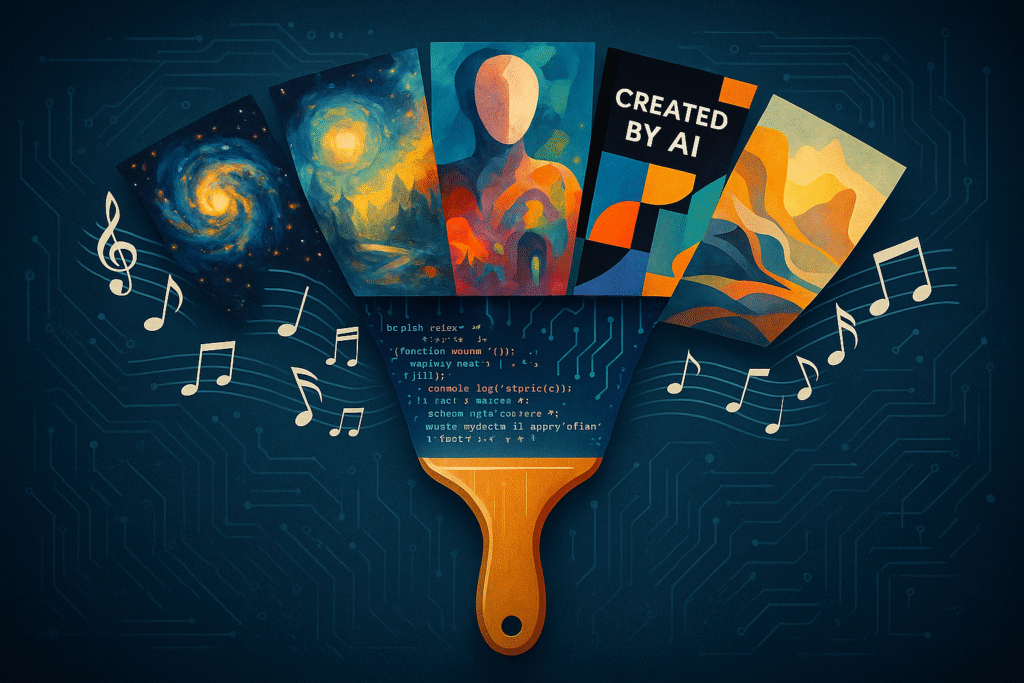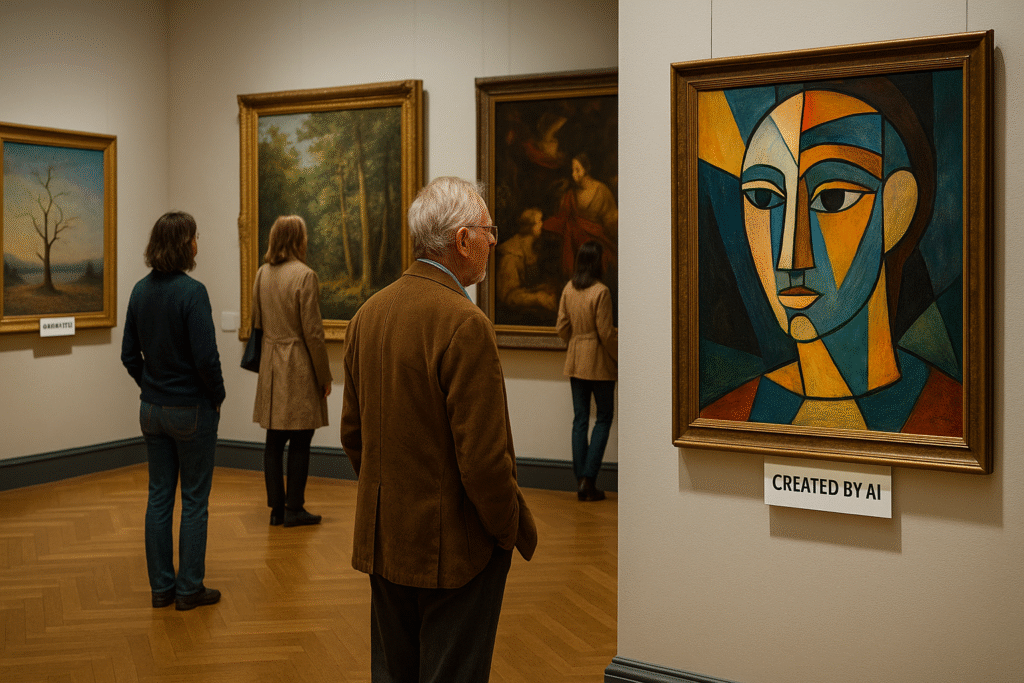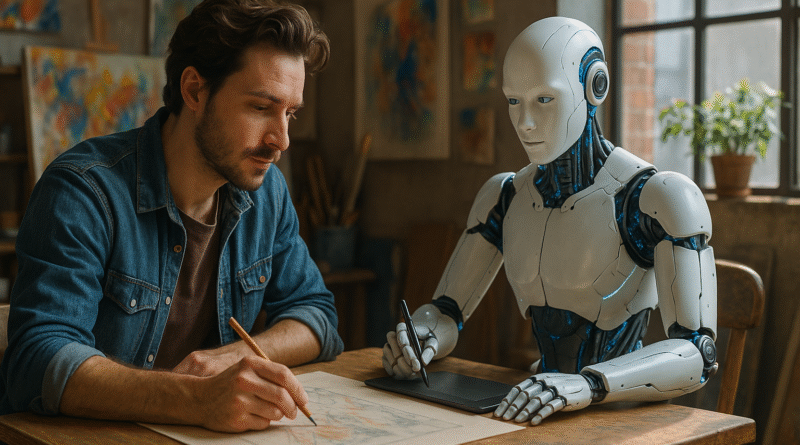AI and Creativity: The Next Generation of Digital Artists
AI and Creativity Introduction
Once upon a time, creativity was considered the final frontier for machines. We thought, “Sure, AI can crunch numbers and beat humans at chess, but paint a masterpiece? Write a song that moves someone to tears? Nah.”
Well… surprise. It turns out Artificial Intelligence can be creative, not just in a mechanical sense, but in a way that’s raising eyebrows (and sometimes dropping jaws) across the art world, music studios, design labs, and beyond.
From AI-generated paintings auctioned for hundreds of thousands of dollars to albums composed with neural networks, we’re witnessing the birth of a new breed of digital creators, and they’re part human, part algorithm.
This article explores how AI is not only participating in creativity, but redefining what it means to create in the 21st century.
Table of Contents
Why This Matters Now
Creativity isn’t just for artists anymore. In the digital age, creativity is currency:
- Designers create visual experiences
- Marketers craft compelling content
- Startups rely on branding, storytelling, and design thinking
But with time constraints, creative block, and demand for faster production, we’re turning to AI tools to boost and sometimes even lead the creative process.
The result?
A new era where human imagination meets machine intelligence, and sparks fly.
1. Generative AI: Meet Your New Creative Collaborator

Generative AI refers to algorithms that can create new content, such as:
- Images
- Music
- Poetry
- 3D models
- Code
- Even voices and film scripts
Popular platforms:
- DALL·E and Midjourney (for image generation)
- ChatGPT and Claude (for text)
- AIVA and Amper (for music)
- RunwayML and Sora (for video editing and generation)
These tools don’t “think” like humans, but they learn from vast datasets and generate original outputs based on prompts. Think of them as supercharged interns with infinite memory and zero fatigue.
2. Visual Art: From Brushstrokes to Bitmaps

AI art is no longer just abstract blobs, it’s gallery-worthy. In fact, in 2018, an AI-generated portrait titled “Edmond de Belamy” sold at Christie’s for over $400,000.
How it works:
- AI is trained on thousands (or millions) of images
- It learns patterns, styles, and techniques
- When prompted, it generates entirely new artwork
Styles include:
- Realism
- Cubism
- Anime
- Cyberpunk
- Surrealist dreamscapes
Use cases:
- Concept art for films and games
- Album covers
- NFTs
- Branding illustrations
- Personalized prints
And the best part? Artists are using AI as a tool, not a threat. It’s like Photoshop on rocket fuel.
3. Music Composition: AI Finds Its Rhythm
What if your next favorite song wasn’t written by a musician, but by a machine?
AI music tools like:
- AIVA: Composes cinematic scores
- Soundraw: Auto-generates royalty-free music for creators
- Amper Music: Builds music based on mood, tempo, and genre
- Google’s MusicLM: Transforms text descriptions into music
Benefits for musicians:
- Rapid ideation (no more writer’s block)
- Customized background tracks for videos
- Harmonic and rhythmic suggestions for producers
- Adaptive soundscapes in video games and AR/VR
AI isn’t replacing composers, it’s giving them new instruments to play with.
4. Writing & Storytelling: Words by the Algorithm

From novels to news articles, AI is penning more content than ever before.
AI writing tools include:
- ChatGPT: Conversational and narrative writing
- Sudowrite: AI for creative writers
- NovelAI: Tailored for fiction
- Jasper: Marketing copy and content generation
Writers are using AI to:
- Brainstorm plot ideas
- Rewrite scenes from new perspectives
- Create dynamic dialogue
- Fill in narrative gaps
Think of it like a collaborative writing partner who’s always available and never judges your typos.
5. Design & Branding: Instant Moodboards, Infinite Iterations
Designers rejoice: AI is making concepting faster and feedback loops tighter.
AI tools like:
- Canva’s Magic Design and Adobe Firefly for auto-design and mockups
- Looka or LogoAI for brand identity generation
- Khroma for color palettes based on your taste
AI design can:
- Suggest layouts based on content
- Test visual appeal with predictive eye-tracking
- Tailor designs for specific audiences
Creative agencies now use AI to generate 100+ versions of a campaign and test which resonates best before going live.
6. Video & Film: Editing That Edits Itself
Video creation has always been resource-heavy, but not anymore.
AI tools like:
- RunwayML: Text-to-video and background removal
- Descript: Video editing via text script
- Pictory: Auto-creates videos from blog content
- Sora by OpenAI: Text-to-high-fidelity video generation (the next frontier)
What AI enables:
- Auto-cuts and transitions
- Lip-sync editing
- Voiceovers in multiple languages
- Animated characters or scenes based on prompts
Yes, even indie creators can now produce cinematic-level content without a full studio.
7. Ethics & Authenticity: Who Owns the Art?
Now, let’s talk about the elephant in the studio.
As AI creates more “original” content, several questions emerge:
- Who owns AI-generated work?
- Is it ethical to train AI on artists’ work without consent?
- Should AI art be labeled?
- Can AI plagiarize if it mimics style too closely?
Some answers (so far):
- In many regions, only humans can hold copyrights.
- AI-created content may need disclosure in some use cases (e.g., journalism).
- New platforms now let artists opt out of datasets (e.g., Spawning.ai).
This isn’t the end of creativity, it’s the start of a new era of creative responsibility.
FAQ
Q1: Will AI replace human artists?
A1: Not likely. AI lacks emotion, lived experience, and cultural nuance. It’s a tool, a powerful one, but the spark of creativity is still uniquely human.
Q2: Is using AI for art considered “cheating”?
A2: Only if you’re pretending it’s 100% your own manual creation. Many artists openly credit AI as a collaborator, just like they would with any digital tool.
Q3: Can beginners use AI to get into creative fields?
A3: Absolutely. AI levels the playing field, allowing anyone to prototype, create, and explore, regardless of technical skill.
Final Thoughts & CTA
AI isn’t here to steal creativity, it’s here to expand it.
Whether you’re a professional artist, a bedroom producer, or just someone who doodles during Zoom calls, AI is giving you more tools, more speed, and more freedom to create.
This new wave of creativity isn’t man vs. machine. It’s man + machine, co-creating in ways we never imagined possible.
So go ahead, write that song, generate that art, design that brand. And let AI be the weird, brilliant, tireless assistant you didn’t know you needed.
Curious about the best AI tools for creators? Want to see real examples of how tech is fueling the next Renaissance?
Stick around at aihunterguides.com, where tech meets art, and we break down innovation without breaking your brain.

Pingback: AI Art Generators: 6 Brilliant Lawsuits Against It